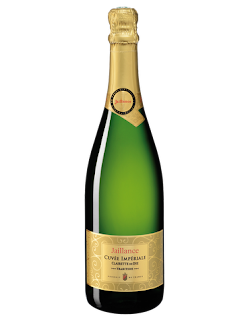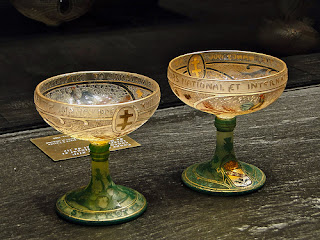Montmorency cherries.
www.flickr.com/photos/152376767@N03/35211992024/
The Cerise or Griotte de Montmorency
Montmorency in the 1800s was a small village near Paris, and the cherries from its orchards brought it fame in all French kitchens. French and other menus around the world still have Montmorency cherries as part of many dishes. These small, slightly sour, but uniquely tasty cherries may be part of an hors-d'oeuvre, an entree, the French starter, or be in the sauce for the main course or dessert. In many desserts and pastries, Montmorency is the cherry of choice.
Montmorency Cherry Blossom.
The cherry orchards that were all around the village of Montmorency have long gone. Montmorency today is a bedroom suburb of Paris with 20,000 inhabitants. There are only a few cherry trees left in Montmorency, but their cuttings are now grown all over the world. Montmorency cherries are by far the most popular sour cherry in North America. French Kirsch, the cherry liquor, comes from many places and the cherry of choice is the Montmorency. (Other sour cherries may be on French menus as griottes).
Montmorency cherries on your French Menus:
Confiture de Cerises de Montmorency – Montmorency cherry jam.
Clafoutis aux Cerises de Montmorency - Clafoutis is a cherry tart that originated in the region of Limousine that is now part of the new super region of Nouvelle Aquitaine. Clafoutis are made in a crepe-like batter and now made with other fruits and ingredients. (Clafoutis is pronounced clafouti).
Crème Brûlée Montmorency - Crème brulée flavored with Montmorency cherries.
Grenadin de Porc Montmorency - A grenadin is a thick cut from the leg of pork or veal. This cut is usually barded, wrapped in strips of fat, usually bacon, while being cooked. Barding keeps the meat from drying out. Here the Montmorency cherries will flavor the pork and be served alongside.
Magret de Canard Montmorency - Duck breast fried with Montmorency cherries.
Gateau Forêt Noire aux Cerises de Montmorency – A Black Forest Gateau is an incredibly rich cake of German origins, but very popular in France. The cake is a layered chocolate cake made with few, but rich, ingredients: Fresh Montmorency cherries, chocolate, butter, cream, kirsch, vanilla, and whipped cream. On the outside, the cake is covered with chocolate shavings and topped with more Montmorency cherries and cream.
Gâteau Foret Noire.
Guignolet Kirsch
The Village of Montmorency
and the two men who made it famous
The village was famous in France for its cherries, but what made the village internationally famous was the work of two people. The first was Jean-Jaques Rousseau (1712 – 1778), the writer and philosopher who lived and wrote most of his works in Montmorency. The second, but no less important was Camille Pissarro (1830 – 1903) who lived in a village nearby. Pissarro with other artists made the village of Montmorency famous with their paintings of its cherry and chestnut orchards.
Picnic at Montmorency
Camille Pissarro
The little village of L'Hermitage, near to Montmorency, was where Pissarro made his home for quite a number of years, but that village has also long gone. The village was just below the town of Pontoise which looked out over the River Oise. You may see Pissarro’s oil painting of The Village of L'Hermitage as it was in 1867 at the Guggenheim Museum, NY.
In Montmorency, there is a Musee de Jean-Jaques Rousseau. It is closed on Sundays and open on Mondays through Saturday from 14:00 (2.00pm) through 18:00 (6:00p). It has a French Language website. Google and Bing translate will help with checking the opening times.
Jean-Jacques Rousseau.
Photograph courtesy of Renaud Camus
Officially, Montmorency is not part of Paris. Despite it being just 14 km (9 miles) as the crow flies from the center of Paris, a bus or car takes close to one hour, and there is no train.
The town of Pontoise had some 5,000 inhabitants when Pissarro lived nearby. Since then Pontoise has changed radically. In the 1960's Pontoise, became the large planned new town of Cergy-Pontoise. Cergy-Pontoise today has only one thing left to remind us of Camille Pissarro, and that is its small Musée Camille Pissarro, the Camille Pissarro museum.
The Museum is open from Wednesdays through Sunday from 14:00 (2.00pm) through 18:00 (6.00pm). However, as with all French museums, check the times. The museum has a page on the Pointoise town's French-language website as the Musée Camille Pissarro. Google and Bing translate apps make reading it straightforward.
The Pissarro museum has some drawings and other works by Pissarro, along with a number of works by Camille Pissarro's contemporaries. The museum has only one Pissarro oil.
Cergy-Pontoise is 20 km (13 miles) from the center of Paris. On the RER C railroad, it is a 20-minute ride. The bedroom suburb of Montmorency and the town of Cergy-Pontoise are both in the department of Val-d'Oise in the region of Ile de France. N.B.: Cergy-Pontoise has little else for visitors. Its population of 200,000 people has high unemployment and a high crime rate.
Connected Posts:
Behind the French Menu’s links include hundreds of words, names, and phrases that are seen on French menus. There are over 400 articles with more than 2,500 French dishes, phrases, food products and produce with English translations and explanations. Just add the word, words or phrase that you are searching for to the words "Behind the French Menu" and search with Google or Bing.
Behind the French Menu
by
Bryan G. Newman
behindthefrenchmenu@gmail.com
Copyright: 2010, 2012, 2015, 2017.





















